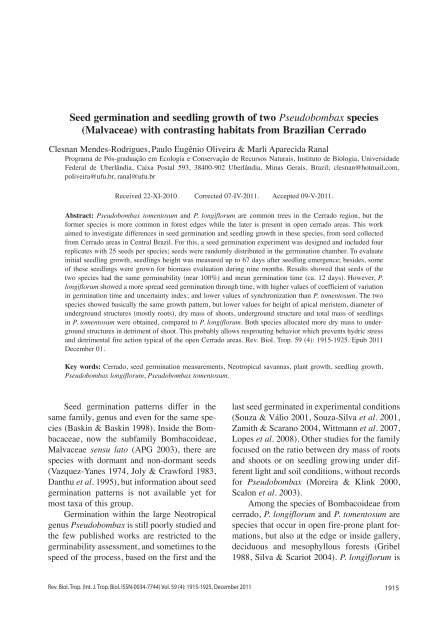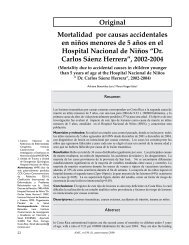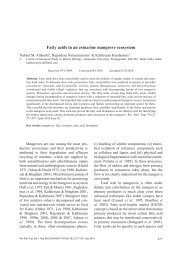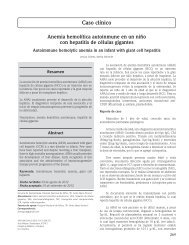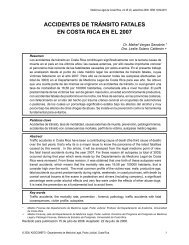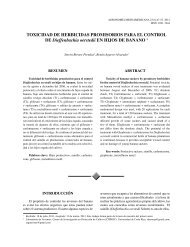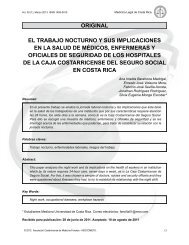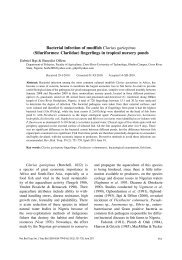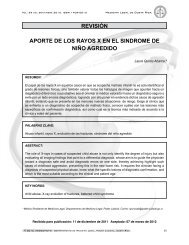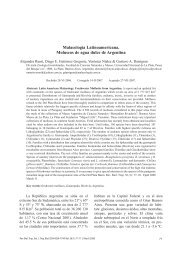Seed germination and seedling growth of two Pseudobombax species
Seed germination and seedling growth of two Pseudobombax species
Seed germination and seedling growth of two Pseudobombax species
You also want an ePaper? Increase the reach of your titles
YUMPU automatically turns print PDFs into web optimized ePapers that Google loves.
<strong>Seed</strong> <strong>germination</strong> <strong>and</strong> <strong>seedling</strong> <strong>growth</strong> <strong>of</strong> <strong>two</strong> <strong>Pseudobombax</strong> <strong>species</strong><br />
(Malvaceae) with contrasting habitats from Brazilian Cerrado<br />
Clesnan Mendes-Rodrigues, Paulo Eugênio Oliveira & Marli Aparecida Ranal<br />
Programa de Pós-graduação em Ecologia e Conservação de Recursos Naturais, Instituto de Biologia, Universidade<br />
Federal de Uberlândia, Caixa Postal 593, 38400-902 Uberlândia, Minas Gerais, Brazil; clesnan@hotmail.com,<br />
poliveira@ufu.br, ranal@ufu.br<br />
Received 22-xi-2010. Corrected 07-iv-2011. Accepted 09-v-2011.<br />
Abstract: <strong>Pseudobombax</strong> tomentosum <strong>and</strong> P. longiflorum are common trees in the Cerrado region, but the<br />
former <strong>species</strong> is more common in forest edges while the later is present in open cerrado areas. This work<br />
aimed to investigate differences in seed <strong>germination</strong> <strong>and</strong> <strong>seedling</strong> <strong>growth</strong> in these <strong>species</strong>, from seed collected<br />
from Cerrado areas in Central Brazil. For this, a seed <strong>germination</strong> experiment was designed <strong>and</strong> included four<br />
replicates with 25 seeds per <strong>species</strong>; seeds were r<strong>and</strong>omly distributed in the <strong>germination</strong> chamber. To evaluate<br />
initial <strong>seedling</strong> <strong>growth</strong>, <strong>seedling</strong>s height was measured up to 67 days after <strong>seedling</strong> emergence; besides, some<br />
<strong>of</strong> these <strong>seedling</strong>s were grown for biomass evaluation during nine months. Results showed that seeds <strong>of</strong> the<br />
<strong>two</strong> <strong>species</strong> had the same germinability (near 100%) <strong>and</strong> mean <strong>germination</strong> time (ca. 12 days). However, P.<br />
longiflorum showed a more spread seed <strong>germination</strong> through time, with higher values <strong>of</strong> coefficient <strong>of</strong> variation<br />
in <strong>germination</strong> time <strong>and</strong> uncertainty index; <strong>and</strong> lower values <strong>of</strong> synchronization than P. tomentosum. The <strong>two</strong><br />
<strong>species</strong> showed basically the same <strong>growth</strong> pattern, but lower values for height <strong>of</strong> apical meristem, diameter <strong>of</strong><br />
underground structures (mostly roots), dry mass <strong>of</strong> shoots, underground structure <strong>and</strong> total mass <strong>of</strong> <strong>seedling</strong>s<br />
in P. tomentosum were obtained, compared to P. longiflorum. Both <strong>species</strong> allocated more dry mass to underground<br />
structures in detriment <strong>of</strong> shoot. This probably allows resprouting behavior which prevents hydric stress<br />
<strong>and</strong> detrimental fire action typical <strong>of</strong> the open Cerrado areas. Rev. Biol. Trop. 59 (4): 1915-1925. Epub 2011<br />
December 01.<br />
Key words: Cerrado, seed <strong>germination</strong> measurements, Neotropical savannas, plant <strong>growth</strong>, <strong>seedling</strong> <strong>growth</strong>,<br />
<strong>Pseudobombax</strong> longiflorum, <strong>Pseudobombax</strong> tomentosum.<br />
<strong>Seed</strong> <strong>germination</strong> patterns differ in the<br />
same family, genus <strong>and</strong> even for the same <strong>species</strong><br />
(Baskin & Baskin 1998). Inside the Bombacaceae,<br />
now the subfamily Bombacoideae,<br />
Malvaceae sensu lato (APG 2003), there are<br />
<strong>species</strong> with dormant <strong>and</strong> non-dormant seeds<br />
(Vazquez-Yanes 1974, Joly & Crawford 1983,<br />
Danthu et al. 1995), but information about seed<br />
<strong>germination</strong> patterns is not available yet for<br />
most taxa <strong>of</strong> this group.<br />
Germination within the large Neotropical<br />
genus <strong>Pseudobombax</strong> is still poorly studied <strong>and</strong><br />
the few published works are restricted to the<br />
germinability assessment, <strong>and</strong> sometimes to the<br />
speed <strong>of</strong> the process, based on the first <strong>and</strong> the<br />
last seed germinated in experimental conditions<br />
(Souza & Válio 2001, Souza-Silva et al. 2001,<br />
Zamith & Scarano 2004, Wittmann et al. 2007,<br />
Lopes et al. 2008). Other studies for the family<br />
focused on the ratio between dry mass <strong>of</strong> roots<br />
<strong>and</strong> shoots or on <strong>seedling</strong> growing under different<br />
light <strong>and</strong> soil conditions, without records<br />
for <strong>Pseudobombax</strong> (Moreira & Klink 2000,<br />
Scalon et al. 2003).<br />
Among the <strong>species</strong> <strong>of</strong> Bombacoideae from<br />
cerrado, P. longiflorum <strong>and</strong> P. tomentosum are<br />
<strong>species</strong> that occur in open fire-prone plant formations,<br />
but also at the edge or inside gallery,<br />
deciduous <strong>and</strong> mesophyllous forests (Gribel<br />
1988, Silva & Scariot 2004). P. longiflorum is<br />
Rev. Biol. Trop. (Int. J. Trop. Biol. ISSN-0034-7744) Vol. 59 (4): 1915-1925, December 2011<br />
1915
much more common in open savanna formations<br />
<strong>and</strong> has hanging bat pollinated flowers<br />
(Coelho & Marinho Filho 2002). P. tomentosum<br />
is much more common in forest habitats<br />
where its sturdy flowers depend on non-flying<br />
mammals passing from crown to crown for<br />
pollination (Gribel 1988). Except from the differences<br />
in habitat, the <strong>species</strong> are similar in<br />
relation to the distribution, phenology <strong>and</strong> seed<br />
dispersion period (Lorenzi 1992, Silva Júnior<br />
et al. 2005). The absence <strong>of</strong> exclusive habitats<br />
between the <strong>two</strong> <strong>species</strong> reflect the presence <strong>of</strong><br />
physiognomic gradients <strong>and</strong> transitions among<br />
savanna <strong>and</strong> forest areas in the Cerrado Biome<br />
(Ribeiro & Walter 1998). The water stress <strong>and</strong><br />
the occurrence <strong>of</strong> seasonal fire in the Cerrado<br />
biome select <strong>species</strong> with ability to resprout<br />
after these events, leading to the allocation <strong>of</strong><br />
available resources to the roots or other underground<br />
structures in detriment <strong>of</strong> the shoots in<br />
open formation <strong>species</strong> while forest <strong>species</strong><br />
show allocation to aerial parts in detriment <strong>of</strong><br />
the roots (H<strong>of</strong>fmann & Franco 2003). Inside<br />
mesophyllous forest <strong>and</strong> gallery forest formations,<br />
light is the limiting factor but habitat<br />
shows less oscillations in water regime <strong>and</strong><br />
temperature, favoring fast <strong>and</strong> synchronized<br />
seed <strong>germination</strong> whenever gaps or leaf fall<br />
cycles improve <strong>seedling</strong> survival chances as<br />
discussed by Garwood (1983). Meanwhile,<br />
in the savanna habitats, the limiting factors<br />
are water <strong>and</strong> nutrients, <strong>and</strong> seed <strong>germination</strong><br />
spread in time, <strong>and</strong> even dormancy, may favor<br />
<strong>seedling</strong> survival (Moreira & Klink 2000,<br />
H<strong>of</strong>fmann & Franco 2003, Oliveira 2008,<br />
Vieira et al. 2008).<br />
In this context, vicariant <strong>species</strong> as the ones<br />
studied here provide the opportunity to see how<br />
habitat specialization would be reflected in<br />
<strong>germination</strong> <strong>and</strong> <strong>seedling</strong> <strong>growth</strong> (H<strong>of</strong>fmann &<br />
Franco 2003). The objective <strong>of</strong> this paper was<br />
to test, on the one h<strong>and</strong>, if seed <strong>germination</strong> <strong>of</strong><br />
P. longiflorum would be more asynchronous<br />
<strong>and</strong> <strong>seedling</strong> mass allocated predominantly in<br />
the underground structures, favoring <strong>seedling</strong><br />
survival in the open savanna areas. On the other<br />
h<strong>and</strong>, for P. tomentosum, typical <strong>of</strong> forest formation<br />
with less water stress, with an expected<br />
more synchronized <strong>germination</strong> process <strong>and</strong><br />
<strong>seedling</strong>s would have more mass allocated to<br />
the stems, favoring light absorption <strong>and</strong> continuous<br />
<strong>growth</strong>.<br />
MATERIAL AND METHODS<br />
Studied <strong>species</strong>: <strong>Pseudobombax</strong> longiflorum<br />
(Mart. & Zucc.) Robyns (Bombacoideae,<br />
Malvaceae) is found in most Cerrado areas. It<br />
is fairly common in Minas Gerais <strong>and</strong> down<br />
to the North <strong>of</strong> Paraná State. It is a deciduous<br />
tree, which occurs sparsely in open Cerrado<br />
areas (Lorenzi 1992). Flowering occurs from<br />
July to November <strong>and</strong> fruits mature during the<br />
next dry season, from July to November (Silva<br />
Júnior et al. 2005). P. tomentosum (Mart. &<br />
Zucc.) Robyns (Bombacoideae, Malvaceae)<br />
is usually a larger tree, found in Cerradão<br />
(dense cerrado with almost closed woodl<strong>and</strong>)<br />
<strong>and</strong> Cerrado (closed vegetation dominated by<br />
trees <strong>and</strong> shrubs with herbaceous vegetation<br />
between them), but mainly in the edges <strong>and</strong><br />
sometimes inside mesophyllous <strong>and</strong> gallery<br />
forests. It occurs in most Cerrado region down<br />
to Southern areas <strong>of</strong> São Paulo <strong>and</strong> Mato<br />
Grosso do Sul. It flowers from July to August<br />
<strong>and</strong> the fruits mature from August to October.<br />
It is a deciduous <strong>and</strong> heliophyllous plant, also<br />
appearing less frequently in open vegetation,<br />
usually on s<strong>and</strong>y or humic clay soils, but also<br />
on better drained oxisoils common in the Cerrado<br />
region (Lorenzi 1992, P.E. Oliveira, pers.<br />
observ.). The voucher specimens can be found<br />
in Herbarium Uberl<strong>and</strong>ense.<br />
Studied area: About 200 seeds <strong>of</strong> both<br />
<strong>species</strong> were collected in the Cerrado areas,<br />
Neotropical savannas region in Central Brazil<br />
(sensu Ribeiro & Walter 1998). The seeds <strong>of</strong><br />
P. tomentosum were collected in forest areas,<br />
near to Uberlândia city, Minas Gerais state<br />
(19º07’ W - 48º22’ S) <strong>and</strong> the seeds <strong>of</strong> P.<br />
longiflorum were collected in adjacent open<br />
pasture <strong>and</strong> areas along the BR050 highway<br />
(17º06’ W - 47º45’ S), between Uberlândia<br />
<strong>and</strong> Brasília. Germination <strong>and</strong> <strong>seedling</strong> <strong>growth</strong><br />
experiments were carried out at the Campus<br />
1916 Rev. Biol. Trop. (Int. J. Trop. Biol. ISSN-0034-7744) Vol. 59 (4): 1915-1925, December 2011
<strong>of</strong> the Federal University <strong>of</strong> Uberlândia. The<br />
region climate is characterized as Aw according<br />
to the Köppen scale (Köppen 1948), tropical<br />
humid climate with a dry winter (April to September)<br />
<strong>and</strong> rainy summer (October to March)<br />
(Rosa et al. 1991).<br />
<strong>Seed</strong> <strong>germination</strong>: Mature fruits <strong>of</strong> both<br />
<strong>species</strong> were collected in September <strong>and</strong> October<br />
2003. The fruits were collected directly<br />
from the trees <strong>and</strong> placed to dry at room temperature<br />
in order to facilitate the extraction <strong>of</strong><br />
the seeds. <strong>Seed</strong>s were stored in paper bags at<br />
room temperature (between 25 <strong>and</strong> 30°C), in a<br />
dry chamber containing silica gel with humidity<br />
indicator, <strong>and</strong> kept until the installation <strong>of</strong><br />
the experiment, 30 days later. The seeds were<br />
sown on fine vermiculite (expansion volume <strong>of</strong><br />
0.1m 3 ), inside transparent <strong>germination</strong> boxes,<br />
moistened as necessary with distilled water.<br />
Boxes were kept in a <strong>germination</strong> chamber<br />
(<strong>Seed</strong>buro Company, model MDG2000) under<br />
continuous light (mean=11.90, SD=6.52µmol/<br />
m 2 /s <strong>of</strong> photosynthetically active radiation), at<br />
25ºC. The experimental units were r<strong>and</strong>omly<br />
distributed in the <strong>germination</strong> chamber, four<br />
replicates for each <strong>species</strong> with 25 seeds per<br />
replicate. The seed sample size was somewhat<br />
limited as a consequence <strong>of</strong> the high level <strong>of</strong><br />
predation <strong>of</strong> fruits <strong>and</strong> seeds during the collection<br />
year. Although seed samples used for the<br />
experiments were rather small, the data was<br />
still sufficient for consistent statistical tests.<br />
The number <strong>of</strong> germinated seeds was<br />
observed daily <strong>and</strong> protrusion <strong>of</strong> the radicle or<br />
any part <strong>of</strong> the embryo was used as <strong>germination</strong><br />
criterion. Germinability (G), represented<br />
by the percentage <strong>of</strong> <strong>germination</strong> in the experimental<br />
conditions (Labouriau 1983), mean<br />
<strong>germination</strong> time (MGT) ( , Labouriau 1970),<br />
<strong>germination</strong> time to 50% <strong>germination</strong> (GT50),<br />
<strong>germination</strong> time <strong>of</strong> the first germinated seed<br />
(GTFS), <strong>germination</strong> time <strong>of</strong> the last germinated<br />
seed (GTLS), coefficient <strong>of</strong> variation <strong>of</strong><br />
the <strong>germination</strong> time (CVGT) (CV t<br />
, Ranal &<br />
Santana 2006), mean <strong>germination</strong> rate (MGR) (<br />
, Labouriau 1970), uncertainty <strong>of</strong> <strong>germination</strong><br />
(UG) (U, Labouriau & Valadares 1976) <strong>and</strong><br />
synchronization index <strong>of</strong> <strong>germination</strong> (ZG) (Z,<br />
Ranal & Santana 2006 adapted from Primack<br />
1980) were used to describe the <strong>germination</strong><br />
process. Further details on mathematical<br />
expressions, authorship, intermediate calculus,<br />
the sense <strong>and</strong> the applications <strong>of</strong> these <strong>germination</strong><br />
measurements can be found in Ranal &<br />
Santana (2006) <strong>and</strong> Ranal et al. (2009). All germinated<br />
seeds were checked for the presence<br />
<strong>of</strong> more than one embryo per seed, known as<br />
polyembryony <strong>and</strong> common in Bombacoideae<br />
(Mendes-Rodrigues et al. 2005).<br />
<strong>Seed</strong>ling morphology <strong>and</strong> height: <strong>Seed</strong>s<br />
germinated in laboratory conditions were transplanted<br />
to black plastic bags (30cm high per<br />
13cm diameter), filled with previously sieved<br />
open Cerrado oxisol. <strong>Seed</strong>lings were kept in<br />
a greenhouse covered with black plastic net<br />
with 50% shading <strong>and</strong> moistened when necessary.<br />
Starting from emergence date, periodic<br />
measurements <strong>of</strong> the maximum height <strong>of</strong> each<br />
plant, considered from ground to the apex <strong>of</strong> the<br />
last leaf were carried out (Fig. 1 H-1). The data<br />
were adjusted to a linear regression model, as a<br />
function <strong>of</strong> the days from emergence. Some 20<br />
P. longiflorum <strong>seedling</strong>s were evaluated up to<br />
67 days after emergence <strong>and</strong> 15 P. tomentosum<br />
<strong>seedling</strong>s up to 63 days after emergence, when<br />
initial <strong>growth</strong> appeared to stabilize (<strong>seedling</strong>s<br />
showed no further increment in height). The<br />
<strong>seedling</strong> functional morphology was classified<br />
based on Miquel (1987). These <strong>seedling</strong>s were<br />
kept for nine months under the same conditions<br />
to asses a biomass allocation evaluation, as<br />
described below.<br />
Biomass allocation: <strong>Seed</strong>lings for biomass<br />
evaluation were analyzed nine months<br />
after sowing, before foliar abscission started.<br />
Seven plants <strong>of</strong> each <strong>species</strong> were removed<br />
from the soil <strong>and</strong> analyzed for the leaf number<br />
per plant, length <strong>of</strong> the shoot (considered from<br />
the soil to the apex <strong>of</strong> the last leaf) (Fig. 1<br />
H-1), height <strong>of</strong> the apical meristem (from soil<br />
to the apical meristem) (Fig. 1 H-2), height<br />
<strong>of</strong> insertion <strong>of</strong> the first leaf from soil (Fig. 1<br />
H-3), diameter at the shoot base, the largest<br />
Rev. Biol. Trop. (Int. J. Trop. Biol. ISSN-0034-7744) Vol. 59 (4): 1915-1925, December 2011<br />
1917
Fig. 1. Development phases <strong>of</strong> <strong>Pseudobombax</strong> <strong>seedling</strong>s, (A-E, G) Development phases <strong>of</strong> P. longiflorum. (F <strong>and</strong> H)<br />
Development phases <strong>of</strong> P. tomentosum. (A) Epygeal <strong>seedling</strong> emergence due to petiole elongation (see the arrow). (B)<br />
Cotyledon leaves with both petioles. (C). Aerial part emission (see the arrow). (D) <strong>Seed</strong>ling with about 9-10 months, without<br />
leaves. (E) <strong>Seed</strong>ling with 9 months; see the massive underground structure. (F) <strong>Seed</strong>ling with 9 months; see the massive<br />
underground structure. (G) Resprouting <strong>of</strong> a <strong>seedling</strong> about 12-18 months from the emergence. (H) <strong>Seed</strong>ling measurements:<br />
1. Plant height, 2. Apical meristem height, 3. Height <strong>of</strong> the insertion <strong>of</strong> the first leaf, 4. Underground structure diameter, 5.<br />
Underground structure length. Scale bars = 2cm.<br />
diameter <strong>of</strong> the underground structure (Fig. 1<br />
H-4) <strong>and</strong> the length <strong>of</strong> the underground structure<br />
(Fig. 1 H-5). The <strong>seedling</strong>s were divided<br />
into aerial (stems <strong>and</strong> leaves) <strong>and</strong> underground<br />
parts (mostly roots), <strong>and</strong> dried to constant<br />
mass at 70ºC (eight days). The dry mass ratio<br />
between underground <strong>and</strong> aerial parts <strong>and</strong><br />
between underground <strong>and</strong> total <strong>seedling</strong> dry<br />
mass were calculated (Hunt 1990). Non-quantitative<br />
observations continued up to 18 months<br />
after sowing.<br />
Germination measurements <strong>and</strong> <strong>seedling</strong><br />
biometry data were evaluated for normality<br />
with the Shapiro-Wilk test. Data with normal<br />
distribution were compared using Student’s<br />
t-test (all <strong>seedling</strong> biometry measurements,<br />
except underground structure length) <strong>and</strong><br />
data without normal distribution were compared<br />
by Mann-Whitney test (all <strong>germination</strong><br />
measurements, plus underground structure<br />
length). The relative frequency <strong>of</strong> seed <strong>germination</strong><br />
was compared between <strong>species</strong> using<br />
the Kolmogorov-Smirnov test. The <strong>seedling</strong><br />
height collected during the first 70 days was<br />
adjusted to a simple linear regression model as<br />
a function <strong>of</strong> the time from emergence <strong>and</strong> the<br />
significance <strong>of</strong> the model tested with ANOVA.<br />
The slope <strong>and</strong> intercept <strong>of</strong> the linear regression<br />
were compared between <strong>species</strong> using Student’s<br />
t-test. For all the statistical analysis 0.05<br />
<strong>of</strong> significance was adopted <strong>and</strong> procedures<br />
were based on Sokal & Rolf (1995).<br />
RESULTS<br />
<strong>Seed</strong> <strong>germination</strong>: <strong>Seed</strong>s <strong>of</strong> P. longiflorum<br />
<strong>and</strong> P. tomentosum did not present<br />
1918 Rev. Biol. Trop. (Int. J. Trop. Biol. ISSN-0034-7744) Vol. 59 (4): 1915-1925, December 2011
significant differences in germinability, mean<br />
<strong>germination</strong> time <strong>and</strong> mean <strong>germination</strong> rate<br />
(Table 1). On the other h<strong>and</strong>, seeds <strong>of</strong> P.<br />
tomentosum presented greater homogeneity<br />
(lower value <strong>of</strong> CVGT) <strong>and</strong> higher synchrony<br />
<strong>of</strong> <strong>germination</strong> (lower value <strong>of</strong> UG <strong>and</strong> higher<br />
value <strong>of</strong> ZG) than P. longiflorum. The first<br />
<strong>germination</strong> was registered for P. longiflorum<br />
four days after the beginning <strong>of</strong> the<br />
experiment <strong>and</strong> the last <strong>germination</strong> occurred<br />
after 20 days. For P. tomentosum <strong>germination</strong><br />
started after seven days <strong>and</strong> continued<br />
up to the 18th day after sowing (Fig. 2). The<br />
distribution <strong>of</strong> the relative frequency <strong>of</strong> <strong>germination</strong><br />
differs between <strong>species</strong> (D=0.1980,<br />
p
<strong>Seed</strong>ling morphology <strong>and</strong> height: The<br />
<strong>seedling</strong>s <strong>of</strong> both <strong>species</strong> presented photosynthetically<br />
active cotyledons exposed above<br />
ground (Fig. 1 A-C) <strong>and</strong> were classified as<br />
phanero-epigeal-foliaceous (PEF sensu Miquel<br />
1987). In classical PEF type the cotyledons<br />
are suspended from the ground by elongation<br />
<strong>of</strong> hypocotyl, while in these <strong>two</strong> <strong>species</strong> <strong>of</strong><br />
<strong>Pseudobombax</strong> the elongation is caused by<br />
elongation <strong>of</strong> cotyledon petiole (Fig. 1 A).<br />
Although cotyledons are hold above ground,<br />
their fixation point remains below ground<br />
(Fig. 1 A-C). The <strong>seedling</strong> height <strong>of</strong> both<br />
<strong>species</strong> was well adjusted to a simple linear<br />
regression model (r 2 =0.8091, F 1,105<br />
=445.02,<br />
p0.05),<br />
presenting basically the same pattern <strong>of</strong> continuous<br />
<strong>growth</strong> during the first 70 days.<br />
Biomass allocation <strong>of</strong> dry mass: Both<br />
<strong>species</strong> presented an underground structure<br />
(mostly roots) which represented about 80% <strong>of</strong><br />
the total mass <strong>of</strong> <strong>seedling</strong>s (Fig. 1 E-F). Among<br />
the analyzed characteristics, the height <strong>of</strong> the<br />
apical meristem, diameter <strong>and</strong> the dry mass<br />
<strong>of</strong> underground structure, shoot <strong>and</strong> whole<br />
<strong>seedling</strong> dry mass were statistically higher in P.<br />
longiflorum in comparison with P. tomentosum<br />
(Table 2). For the other characteristics there<br />
were no significant differences. Both <strong>species</strong><br />
cessed <strong>growth</strong> between 10 <strong>and</strong> 12 months, followed<br />
by leaf loss <strong>and</strong> resprout after the cool<br />
dry period (Fig. 1 D-G).<br />
Height <strong>of</strong> <strong>seedling</strong> (mm)<br />
140<br />
A<br />
120<br />
100<br />
y = 1.2496x + 23.555<br />
80<br />
60<br />
40<br />
20<br />
0<br />
0 10 20 30 40 50 60 70<br />
Height <strong>of</strong> <strong>seedling</strong> (mm)<br />
140<br />
B<br />
120<br />
y = 1.2867x + 29.822<br />
100<br />
80<br />
60<br />
40<br />
20<br />
0<br />
0 10 20 30 40 50 60 70<br />
Time after emergency (day)<br />
Fig. 3. Growth in height <strong>of</strong> <strong>two</strong> <strong>Pseudobombax</strong> <strong>species</strong> (Bombacoideae, Malvaceae) <strong>seedling</strong>s cultivated under 50% shading<br />
in Uberlândia, Minas Gerais state, Brazil. (A) P. longiflorum. (B) P. tomentosum.<br />
1920 Rev. Biol. Trop. (Int. J. Trop. Biol. ISSN-0034-7744) Vol. 59 (4): 1915-1925, December 2011
TABLE 2<br />
Mean <strong>of</strong> biometry <strong>and</strong> allocation <strong>of</strong> dry matter in <strong>seedling</strong>s (±SD) <strong>of</strong> P. longiflorum <strong>and</strong> P. tomentosum (Bombacoideae,<br />
Malvaceae), cultivated by nine months under 50% <strong>of</strong> natural light in Uberlândia, Minas Gerais state, Brazil<br />
Measurement (unity) P. longiflorum P. tomentosum Statistics 1 p 2<br />
Number <strong>of</strong> leaves 4.00±0.67 4.28±0.90 t=0.60 0.5577<br />
<strong>Seed</strong>ling height (mm) 128.29±13.41 118.30±17.79 t=1.19 0.2585<br />
Apical meristem height (mm) 59.07±9.33 41.06±8.49 t=3.78 0.0026<br />
Shoot diameter (mm) 6.56±0.98 6.94±1.27 t=0.63 0.5373<br />
Underground structure length (mm) 113.95±18.23 109.19±13.51 U=29.00 0.6200<br />
Underground structure diameter (mm) 24.54±1.14 20.60±1.33 t=5.96 0.0001<br />
Height <strong>of</strong> the first leaf insertion (mm) 29.30±11.44 23.07±6.98 t=1.23 0.2425<br />
Aerial dry mass (mg) 1 179.76±156.52 981.67±181.15 t=2.19 0.0490<br />
Underground dry mass (mg) 6 145.10±277.16 4 310.81±1142.06 t=4.13 0.0061<br />
<strong>Seed</strong>ling dry mass (mg) 7 324.86±331.90 5 292.48±1200.35 t=4.32 0.0050<br />
Underground/aerial dry mass ratio 5.09±0.64 4.27±1.06 t=1.76 0.1030<br />
Aerial/<strong>seedling</strong> mass ratio 0.16±0.02 0.20±0.001 t=1.98 0.0707<br />
1. t=statistics <strong>of</strong> the t “Student” test, U=statistics <strong>of</strong> the Mann Whitney test.<br />
2. p=probability.<br />
DISCUSSION<br />
Both <strong>species</strong> <strong>of</strong> <strong>Pseudobombax</strong> presented<br />
high germinability <strong>and</strong> similar <strong>growth</strong> patterns,<br />
but there were some differences in <strong>germination</strong><br />
time <strong>and</strong> synchrony, which may be associated<br />
to their preferential habitat. The high germinability<br />
<strong>of</strong> the seeds <strong>of</strong> both <strong>Pseudobombax</strong><br />
studied <strong>species</strong> is similar to the one observed in<br />
other Bombacoideae (Melo et al. 1979, Sousa-<br />
Silva et al. 2001, Scalon et al. 2003, Zamith &<br />
Scarano 2004, Fanti & Perez 2005, Maia et al.<br />
2005, Wittmann et al. 2007, Lopes et al. 2008,<br />
Zamora-Cornelio et al. 2010), <strong>and</strong> contrast<br />
with lower germinability recorded for other<br />
<strong>species</strong> <strong>of</strong> <strong>Pseudobombax</strong> (Sánchez & Zepeda<br />
2004, Sautu et al. 2006). This also indicates<br />
the absence <strong>of</strong> marked dormancy in <strong>Pseudobombax</strong>,<br />
although <strong>species</strong> with mechanical dormancy<br />
occur in Bombacoideae (Danthu et al.<br />
1995, Barbosa et al. 2004, Pinto et al. 2004).<br />
The <strong>germination</strong> process <strong>of</strong> both <strong>species</strong><br />
was relatively slower; with mean <strong>germination</strong><br />
times higher than the 5.1 to 7.1 days recorded<br />
for other Bombacoideae (Souza & Válio 2001,<br />
Ranal et al. 2010), but was similar to <strong>seedling</strong><br />
emergence times described for the group<br />
(Mendes-Rodrigues et al. 2005). The <strong>germination</strong><br />
time to 50% <strong>of</strong> <strong>germination</strong> (GT50) was<br />
also higher than the 5 to 7 days recorded for<br />
other <strong>species</strong> in the group (Maia et al. 2005,<br />
Zamora-Cornelio et al. 2010).<br />
The duration <strong>of</strong> <strong>germination</strong> process was<br />
distributed along 4.50 to 18.25 days in the studied<br />
<strong>species</strong> (Germination time <strong>of</strong> the first seed-<br />
GTFS <strong>and</strong> <strong>of</strong> the last seed-GTLS), which is<br />
inside the ample variation recorded for <strong>species</strong><br />
in the group, which ranged from 3 (Zamora-<br />
Cornelio et al. 2010) to 19 days (Sautu et al.<br />
2006) to GTFS <strong>and</strong> from 6 (Zamora-Cornelio<br />
et al. 2010) to 284 days (Sautu et al. 2006)<br />
to GTLS.<br />
The gradual <strong>germination</strong> process for both<br />
studied <strong>species</strong> <strong>of</strong> <strong>Pseudobombax</strong> can be considered<br />
a type <strong>of</strong> relative dormancy (sensu<br />
Labouriau 1983). It is not a mechanical dormancy<br />
as observed for Ochroma pyramidale<br />
(Cav. ex Lam.) Urb. (Zamora-Cornelio et al.<br />
2010), but it results in a <strong>germination</strong> process<br />
spread through time in opposition to a single<br />
<strong>germination</strong> peak observed in e.g. Ceiba speciosa<br />
(A.St.-Hil., A.Juss. & Cambess.) Ravenna<br />
(Ranal et al. 2010). This strategy <strong>of</strong> spreading<br />
the <strong>germination</strong> through time is present in<br />
Rev. Biol. Trop. (Int. J. Trop. Biol. ISSN-0034-7744) Vol. 59 (4): 1915-1925, December 2011<br />
1921
other <strong>species</strong> occurring in the Cerrado region<br />
(Carvalho et al. 2005, Pereira et al. 2009, Ranal<br />
et al. 2010, Mendes-Rodrigues et al. 2010).<br />
P. tomentosum showed significantly higher<br />
synchronization <strong>of</strong> <strong>germination</strong> than that<br />
observed for P. longiflorum seeds. The more<br />
asynchronous <strong>and</strong> heterogeneous <strong>germination</strong><br />
observed for P. longiflorum seeds would<br />
increase survival ability at the beginning <strong>of</strong><br />
the rains, which may vary in intensity <strong>and</strong> frequency<br />
in the Cerrado region (Oliveira 2008).<br />
The <strong>seedling</strong>s <strong>of</strong> the <strong>two</strong> <strong>species</strong> <strong>of</strong> <strong>Pseudobombax</strong><br />
differed from others <strong>species</strong> within<br />
the subfamily as Bombacopsis glabra (Pasq.)<br />
A. Robyns (Baker 1960) <strong>and</strong> Eriotheca pubescens<br />
Schott & Endl. (Mendes-Rodrigues et al.<br />
2005) which are polyembrionic. The functional<br />
morphology type <strong>of</strong> <strong>seedling</strong>s <strong>of</strong> P. longiflorum<br />
<strong>and</strong> P. tomentosum differed from P. ellipticum<br />
(Kunth) Dug<strong>and</strong> <strong>and</strong> P. munguba (Mart. &<br />
Zucc.) Dug<strong>and</strong>, which present the cotyledons<br />
suspended by hypocotyl elongation (Sánchez &<br />
Zepeda 2004, Maia et al. 2005), a pattern commonly<br />
observed in classical PEF type (Ressel<br />
et al. 2004).<br />
P. longiflorum <strong>and</strong> P. tomentosum presented<br />
similar <strong>growth</strong> pattern during the first<br />
70 days. This trend <strong>of</strong> linear initial <strong>growth</strong> has<br />
been also observed for other Bombacoideae<br />
such as Ceiba pent<strong>and</strong>ra (L.) Gaertn. (Pedroso<br />
& Varela 1995) <strong>and</strong> B. glabra (Scalon et al.<br />
2003). The leaf fall <strong>and</strong> resprout after the cooler<br />
part <strong>of</strong> the dry season were not previously<br />
recorded for <strong>Pseudobombax</strong>, but this brevideciduous<br />
leafing behavior is common among<br />
<strong>seedling</strong>s <strong>of</strong> other Cerrado <strong>species</strong> (Oliveira &<br />
Silva 1993, Oliveira 2008).<br />
Larger <strong>seedling</strong>s observed in P. longiflorum<br />
in relation to P. tomentosum could also be<br />
viewed as a way to increase chances <strong>of</strong> survival,<br />
since open Cerrado plants have a limited<br />
growing season (Oliveira 2008). Nevertheless,<br />
both <strong>species</strong> presented seasonal <strong>growth</strong> <strong>and</strong> dry<br />
matter allocation ratios similar to other Cerrado<br />
trees (Oliveira & Silva 1993, Moreira & Klink<br />
2000). Despite their difference in predominant<br />
habitat, the <strong>two</strong> <strong>species</strong> <strong>of</strong> <strong>Pseudobombax</strong> allocated<br />
most dry mass to underground structures<br />
in detriment <strong>of</strong> the shoots. This root biased allocation<br />
would allow greater resistance to water<br />
<strong>and</strong> temperature stress during the dry period<br />
in open Cerrado plant formations, but would<br />
hinder competition <strong>and</strong> <strong>growth</strong> in forest environments<br />
(H<strong>of</strong>fmann & Franco 2003, Vieira<br />
et al. 2008). The preferential investment to<br />
underground structures has been also recorded<br />
for other <strong>species</strong> from open Cerrado formations<br />
(Moreira & Klink 2000, H<strong>of</strong>fmann & Franco<br />
2003), including some <strong>species</strong> <strong>of</strong> Bombacoideae<br />
(Moreira & Klink 2000, Ronquim et al.<br />
2003, Ressel et al. 2004). But even for vicariant<br />
pairs <strong>of</strong> <strong>species</strong> restricted to either the savanna<br />
or forest, the physiological <strong>and</strong> developmental<br />
features were not easy to contrast (H<strong>of</strong>fmann &<br />
Franco 2003). It is important to notice here that<br />
the differences in <strong>seedling</strong> size may be a result<br />
<strong>of</strong> a better adjustment <strong>of</strong> P. longiflorum seeds to<br />
the Cerrado soil used in the experiment.<br />
Although the <strong>two</strong> <strong>Pseudobombax</strong> <strong>species</strong><br />
differ in synchrony <strong>of</strong> <strong>germination</strong> <strong>and</strong> in some<br />
aspects <strong>of</strong> <strong>growth</strong> pattern, those differences<br />
are not clearcut <strong>and</strong> may be explained by the<br />
distribution overlap between <strong>species</strong>. New <strong>and</strong><br />
more refined experiments will be necessary to<br />
see whether these differences, despite being<br />
significant, would really favour habitat specialization<br />
in the studied <strong>species</strong>.<br />
ACKNOWLEDGMENTS<br />
Thanks to Conselho Nacional de Desenvolvimento<br />
Científico e Tecnológico – CNPq,<br />
<strong>and</strong> Fundação de Amparo à Pesquisa do Estado<br />
de Minas Gerais – FAPEMIG for the research<br />
grant to the first author <strong>and</strong> the Denise Garcia<br />
de Santana for help in some <strong>of</strong> the statistical<br />
analysis. To Glauco Machado <strong>and</strong> Felipe<br />
W<strong>and</strong>erley Amorim for the reading <strong>of</strong> the<br />
first versions <strong>of</strong> the manuscript <strong>and</strong> to Francielle<br />
Paulina de Araújo for the revision <strong>of</strong><br />
the resumen. The results are part <strong>of</strong> the MSc.<br />
dissertation <strong>of</strong> the first author in the Post-<br />
Graduate Program <strong>of</strong> Ecology <strong>and</strong> Conservation<br />
<strong>of</strong> Natural Resources – Universidade<br />
Federal de Uberlândia.<br />
1922 Rev. Biol. Trop. (Int. J. Trop. Biol. ISSN-0034-7744) Vol. 59 (4): 1915-1925, December 2011
RESUMEN<br />
<strong>Pseudobombax</strong> tomentosum y P. longiflorum son<br />
árboles comunes en la región del Cerrado, pero la primera<br />
especie es más común en los bordes del bosque mientras<br />
que el segundo está presente en áreas abiertas del cerrado.<br />
Este trabajo tuvo como objetivo investigar las diferencias<br />
en la germinación de las semillas y el crecimiento de<br />
ambas e<strong>species</strong>. Los individuos fueron recolectados en<br />
áreas del Cerrado, la región de savanas neotropicales en<br />
el centro de Brasil. Fueron utilizados para cada especie<br />
cuatro repeticiones con 25 semillas cada una para el experimento<br />
de germinación, distribuidas al azar en la cámara<br />
de germinación a 25ºC. Las plántulas fueron evaluadas en<br />
cuanto al crecimiento inicial hasta 67 días después de la<br />
emergencia de la plántula. Algunas plantas se mantuvieron<br />
para la evaluación de la biomasa durante nueve meses, y<br />
luego se mideron para evaluar diferencias en el crecimiento<br />
y distribución de masas entre e<strong>species</strong>. Ambas presentaron<br />
la misma capacidad germinativa (cerca de 100%) y tiempo<br />
medio de germinación (alrededor de 12 días). Sin embargo,<br />
P. longiflorum presentó una germinación más dispersa en el<br />
tiempo, con valores más altos de coeficiente de variación<br />
de tiempo de germinación y el índice de incertidumbre, y<br />
valores más bajos de la sincronización que P. tomentosum.<br />
Las dos e<strong>species</strong> demostraron básicamente el mismo patrón<br />
de crecimiento, pero P. tomentosum presentó valores más<br />
pequeños en la altura del meristemo apical, diámetro de<br />
las estructuras subterráneas (sobre todo las raíces), masa<br />
seca de la estructura aérea, estructura subterránea y plántulas<br />
en comparación con P. longiflorum. Ambas e<strong>species</strong><br />
asimilaron más masa seca en las estructuras subterráneas<br />
en detrimento de las aéreas. Esto probablemente permite<br />
una conducta de rebrote que evita el estrés hídrico y<br />
la acción perjudicial de incendios típicos de las zonas<br />
del cerrado abierto.<br />
Palabras clave: Bombacoideae, Cerrado, germinación de<br />
semillas, savanas neotropicales, crecimiento de las plantas,<br />
<strong>Pseudobombax</strong> tomentosum, <strong>Pseudobombax</strong> longiflorum.<br />
REFERENCES<br />
APG. 2003. An update <strong>of</strong> the Angiosperm Phylogeny<br />
Group classification for the orders <strong>and</strong> families <strong>of</strong><br />
flowering plants: APG II. Bot. J. Linn. Soc. 141:<br />
399-436.<br />
Baker, H.G. 1960. Apomixis <strong>and</strong> polyembryony in Pachira<br />
oleaginea (Bombacaceae). Amer. J. Bot. 47: 296-302.<br />
Barbosa, A.P., P.T.B. Sampaio, M.A.A. Campos, V.P.<br />
Varela, C.Q.B. Gonçalves & S. Iida. 2004. Alternative<br />
technology for breaking dormancy <strong>of</strong> balsa<br />
wood (Ochroma lagopus Sw., Bombacaceae) seeds.<br />
Acta Amazonica 34: 107-110 (also available on-line:<br />
www.scielo.br/pdf/aa/v34n1/v34n1a13.pdf).<br />
Baskin, C.C. & J.M. Baskin. 1998. <strong>Seed</strong>s: ecology, biogeography,<br />
<strong>and</strong> evolution <strong>of</strong> dormancy <strong>and</strong> <strong>germination</strong>.<br />
Academic, San Diego, California, USA.<br />
Carvalho, M.P., D.G. Santana & M.A. Ranal. 2005.<br />
Anacardium humile A. St.-Hil. (Anacardiaceae) <strong>seedling</strong><br />
emergence evaluated by means <strong>of</strong> small samples.<br />
Rev. Bras. Bot. 28: 627-633 (also available<br />
on-line: www.scielo.br/pdf/rbb/v28n3/29011.pdf).<br />
Coelho, D.C. & J. Marinho Filho. 2002. Diet <strong>and</strong> activity <strong>of</strong><br />
Lonchophylla dekeyseri (Lonchophyllinae, Phyllostomidae)<br />
in the Federal District, Brazil. Mammalia<br />
66: 319-330.<br />
Danthu, P., J. Roussel, A. Gaye & E.H.E. Mazzoudi. 1995.<br />
Baobab (Adansonia digitada L.) seed pretreatments<br />
for <strong>germination</strong> improvement. <strong>Seed</strong> Sci. Technol.<br />
23: 469-475.<br />
Fanti, S.C. & S. Perez. 2005. Effects <strong>of</strong> accelerating aging on<br />
the seed vigor <strong>of</strong> Chorisia speciosa St. Hil. - Bombacaceae.<br />
R. Árvore 29: 345-352 (also available on-line:<br />
http://www.scielo.br/pdf/rarv/v29n3/a01v29n3.pdf).<br />
Garwood, N.C. 1983. <strong>Seed</strong> <strong>germination</strong> in a seasonal<br />
tropical forest in Panama: A community study. Ecol.<br />
Monogr. 53: 159-181.<br />
Gribel, R. 1988. Visitis <strong>of</strong> Caluromys lanatus (Didelphidae)<br />
to flowers <strong>of</strong> <strong>Pseudobombax</strong> tometosum<br />
(Bombacaceae): A probable case <strong>of</strong> pollination by<br />
marsupials in Central Brazil. Biotropica 20: 344-347.<br />
H<strong>of</strong>fmann, W.A. & A.C. Franco. 2003. Comparative<br />
<strong>growth</strong> analysis <strong>of</strong> tropical forest <strong>and</strong> savanna woody<br />
plants using phylogenetically independent contrasts.<br />
J. Eco. 91: 475-484.<br />
Hunt, R. 1990. Basic <strong>growth</strong> analysis: Plant <strong>growth</strong> analysis<br />
for beginners. Unwin Hyman, London, United<br />
Kingdom.<br />
Joly, C.A. & R.M.M. Crawford. 1983. Germination <strong>and</strong><br />
some aspects <strong>of</strong> the metabolism <strong>of</strong> Chorisia speciosa<br />
St. Hill. seeds under anoxia. Rev. Bras. Bot. 6: 85-90.<br />
Köppen, W. 1948. Climatología: con un estudio de los<br />
climas de la Tierra. Fondo de Cultura Económica,<br />
México D.F., México.<br />
Labouriau, L.G. 1970. On the physiology <strong>of</strong> seed <strong>germination</strong><br />
in Vicia graminea Sm - I. An. Acad. Bras. Cienc.<br />
42: 235-262.<br />
Labouriau, L.G. 1983. A germinação das sementes. Organização<br />
dos Estados Americanos. Programa Regional<br />
de Desenvolvimento Científico e Técnologico. Série<br />
Rev. Biol. Trop. (Int. J. Trop. Biol. ISSN-0034-7744) Vol. 59 (4): 1915-1925, December 2011<br />
1923
de Biologia. Monografia 24, Washington, Washington,<br />
USA.<br />
Labouriau, L.G. & M.E.B. Valadares. 1976. On the <strong>germination</strong><br />
<strong>of</strong> seeds <strong>of</strong> Calotropis procera (Ait.) Ait.f. An.<br />
Acad. Bras. Cienc. 48: 263-284.<br />
Lopes, J.C., M.T. Matheus, N.B. Corrêa & D.P. Silva.<br />
2008. Germinação de sementes de embiruçu (<strong>Pseudobombax</strong><br />
gr<strong>and</strong>iflorum (Cav.) A. Robyns) em diferentes<br />
estádios de maturação e substratos. Floresta<br />
38: 331-337 (also available on-line: ojs.c3sl.ufpr.br/<br />
ojs2/index.php/floresta/article/viewFile/11628/8162).<br />
Lorenzi, H. 1992. Árvores brasileiras: manual de identificação<br />
e cultivo de plantas arbóreas nativas do Brasil.<br />
Plantarum, Nova Odessa, São Paulo, Brasil.<br />
Maia, L.A., S. Maia & P. Parolin. 2005. <strong>Seed</strong>ling morphology<br />
<strong>of</strong> non-pioneer trees in Central Amazonian<br />
várzea floodplain forests. Ecotropica 11: 1-8 (also<br />
available on-line: www.gtoe.de/public_html/publications/pdf/11%201/Maia,%20Maia%20&%20Parolin,%202005.pdf).<br />
Melo, J.T., J.F. Ribeiro & V.L.G.F. Lima. 1979. Germinação<br />
de sementes de algumas espécies arbóreas<br />
nativas do Cerrado. Rev. Bras. Sem. 1: 9-12 (also<br />
available on-line: www.abrates.org.br/revista/artigos/1979/v1n2/artigo01.pdf).<br />
Mendes-Rodrigues, C., R. Carmo-Oliveira, S. Talavera, M.<br />
Arista, P.L. Ortiz & P.E. Oliveira. 2005. Polyembryony<br />
<strong>and</strong> apomixis in Eriotheca pubescens (Malvaceae<br />
- Bombacoideae). Plant Biol. 7: 533-540.<br />
Mendes-Rodrigues, C., F.P. de Araújo, C. Barbosa-Souza,<br />
V. Barbosa-Souza, M.A. Ranal, D.G. de Santana &<br />
P.E. Oliveira. 2010. Multiple dormancy <strong>and</strong> maternal<br />
effect on Miconia ferruginata DC. (Melastomataceae)<br />
seed <strong>germination</strong>, Serra de Caldas Novas,<br />
Goiás, Brazil. Rev. Bras. Bot. 33: 93-105 (also available<br />
on-line: www.scielo.br/pdf/rbb/v33n1/09.pdf).<br />
Miquel, S. 1987. Morphologie fonctionnele de plantules<br />
d’espèces forestières du Gabon. Bull. Mus. Hist. Nat.<br />
9: 101-121.<br />
Moreira, A.G. & C.A. Klink. 2000. Biomass allocation <strong>and</strong><br />
<strong>growth</strong> <strong>of</strong> tree <strong>seedling</strong>s from <strong>two</strong> contrasting Brazilian<br />
savannas. Ecotropicos 13: 43-51.<br />
Oliveira, P.E.A.M. 2008. Fenologia e biologia reprodutiva<br />
de espécies de Cerrado, p. 273-290. In S.M. Sano,<br />
S.P. de Almeida & J.F. Ribeiro (eds.). Cerrado:<br />
ecologia e flora. Embrapa Informação Tecnológica,<br />
Brasília, Brasil.<br />
Oliveira, P.E.A.M. & J.C.S. Silva. 1993. Reproductive<br />
biology <strong>of</strong> <strong>two</strong> <strong>species</strong> <strong>of</strong> Kielmeyera (Guttiferae) in<br />
the Cerrados <strong>of</strong> Central Brazil. J. Trop. Ecol. 9: 67.<br />
Pedroso, S.G. & V.P. Varela. 1995. Efeito do sombreamento<br />
no crescimento de mudas de sumaúma (Ceiba<br />
pent<strong>and</strong>ra (L.) Gaertn). Rev. Bras. Sem. 17: 47-51<br />
(also available on-line: www.abrates.org.br/revista/<br />
artigos/1995/v17n1/artigo09.pdf).<br />
Pereira, R.S., D.G. Santana & M.A. Ranal. 2009. Emergência<br />
de plântulas oriundas de sementes recémcolhidas<br />
e armazenadas de Copaifera langsdorffii<br />
Desf. (Caesalpinioideae), Triângulo Mineiro, Brasil.<br />
R. Árvore 33: 643-652 (also available on-line: www.<br />
scielo.br/pdf/rarv/v33n4/v33n4a07.pdf).<br />
Pinto, A.M., M.T. Inoue & A.C. Nogueira. 2004. Conservation<br />
<strong>and</strong> vigour <strong>of</strong> balsawood seeds (Ochroma pyramidale).<br />
Acta Amazonica 34: 233-236 (also available<br />
on-line: www.scielo.br/pdf/aa/v34n2/v34n2a10.pdf).<br />
Primack, R.B. 1980. Variation in the phenology <strong>of</strong> naturalpopulations<br />
<strong>of</strong> montane shrubs in New-Zeal<strong>and</strong>. J.<br />
Ecol. 68: 849-862.<br />
Ranal, M.A. & D.G. Santana. 2006. How <strong>and</strong> why to<br />
measure the <strong>germination</strong> process? Rev. Bras. Bot. 29:<br />
1-11 (also available on-line: www.scielo.br/pdf/rbb/<br />
v29n1/a02v29n1.pdf ).<br />
Ranal, M.A., D.G. Santana, W.R. Ferreira & C. Mendes-<br />
Rodrigues. 2009. Calculating <strong>germination</strong> measurements<br />
<strong>and</strong> organizing spreadsheets. Rev. Bras. Bot.<br />
32: 849-855 (also available on line: www.scielo.br/<br />
pdf/rbb/v32n4/a22v32n4.pdf).<br />
Ranal, M.A., D.G. Santana & I. Schiavini. 2010. Are<br />
there <strong>germination</strong> patterns for cerrado <strong>species</strong>?, p.<br />
106-159. In K. Del-Claro, P.S. Oliveira, V. Rico-<br />
Gray, A.A.A. Barbosa, A. Bonet, F.R. Scarno, F.J.M.<br />
Garzón, M.V. Sampaio, M.R. Morris, N. Ramirez,<br />
O. Marçal Júnior, R.H.F. Macedo, R.J. Marquis, L.<br />
Coelho, R.P. Martins, S.C. Rodrigues & U. Luttge<br />
(eds.). Encyclopedia <strong>of</strong> life support systems. Tropical<br />
biology <strong>and</strong> conservation management, savannah<br />
ecosystems, UNESCO/EOLSS. Encyclopedia <strong>of</strong> life<br />
support systems, Oxford, Engl<strong>and</strong> (also available on<br />
line: www.eolss.net).<br />
Ressel, K., F.A.G. Guilherme, I. Schiavini & P.E. Oliveira.<br />
2004. Functional morphology <strong>and</strong> ecology <strong>of</strong> tree<br />
<strong>species</strong> <strong>seedling</strong>s <strong>of</strong> the Ecological Station <strong>of</strong> Panga,<br />
Uberlândia, Minas Gerais. Rev. Bras. Bot. 27: 311-<br />
323 (also available on-line: www.scielo.br/pdf/rbb/<br />
v27n2/v27n2a10.pdf).<br />
1924 Rev. Biol. Trop. (Int. J. Trop. Biol. ISSN-0034-7744) Vol. 59 (4): 1915-1925, December 2011
Ribeiro, J.F. & B.M.T. Walter. 1998. Fit<strong>of</strong>isionomias<br />
do bioma cerrado, p. 89-166. In S.M. Sano & S.P.<br />
Almeida (eds.). Cerrado: ambiente e flora. Embrapa<br />
Planaltina, Brasília, Brasília, Brasil.<br />
Ronquim, C.C., C.H.B.A. Prado & N.F. Paula. 2003.<br />
Growth <strong>and</strong> photosynthetic capacity in <strong>two</strong> woody<br />
<strong>species</strong> <strong>of</strong> cerrado vegetation under different radiation<br />
availability. Braz. Arch. Biol. Technol. 46: 243-252.<br />
Rosa, R., S.C. Lima & W.L. Assunção. 1991. Abordagem<br />
preliminar das condições climáticas de Uberlândia,<br />
MG. Soc. Nat. 3: 91-108.<br />
Sánchez, O.S. & C.H. Zepeda. 2004. Estudio morfológico<br />
de plántulas de la familia Bombacaceae en Quintana<br />
Roo, México. Foresta Veracruzana 6: 1-6 (also available<br />
on-line: redalyc.uaemex.mx/redalyc/src/inicio/<br />
ArtPdfRed.jsp?iCve=49760201).<br />
Sautu, A., J.M. Baskin, C.C. Baskin & R. Condit. 2006.<br />
Studies on the seed biology <strong>of</strong> 100 native <strong>species</strong><br />
<strong>of</strong> trees in a seasonal moist tropical forest, Panama,<br />
Central America. For. Ecol. Manag. 234: 245-263.<br />
Scalon, S.P.Q., R.M. Mussury, M.R. Rigoni & H.S. Filho.<br />
2003. Initial <strong>growth</strong> <strong>of</strong> Bombacopsis glabra (Pasq.)<br />
A. Robyns <strong>seedling</strong>s under shading conditions. R.<br />
Árvore 27: 753-758 (also available on-line: www.<br />
scielo.br/pdf/rarv/v27n6/a01v27n6.pdf).<br />
Silva Júnior, M.C., G.C. Santos, P.E. Nogueira, C.B.R.<br />
Munhoz & A.E. Ramos. 2005. 100 Árvores do Cerrado:<br />
guia de campo. Rede de Sementes do Cerrado,<br />
Brasília, Brasília, Brasil.<br />
Silva, L.A. & A. Scariot. 2004. Arboreal community <strong>of</strong> a<br />
seasonal deciduous forest on limestone outcrop in<br />
São Domingos-Goiás, Parana river Basin, Brazil. R.<br />
Árvore 28: 61-67 (also available on-line: www.scielo.<br />
br/pdf/rarv/v28n1/a08v28n1.pdf).<br />
Sokal, R.R. & F.J. Rohlf. 1995. Biometry the principles <strong>and</strong><br />
practice <strong>of</strong> statistics in biological research. Freeman,<br />
New York, USA.<br />
Souza, R.P. & I.F.M. Válio. 2001. <strong>Seed</strong> size, seed <strong>germination</strong>,<br />
<strong>and</strong> <strong>seedling</strong> survival <strong>of</strong> Brazilian tropical tree <strong>species</strong><br />
differing in successional status. Biotropica 33: 447-457.<br />
Souza-Silva, J.C., J.F. Ribeiro, C.E.L. Fonseca & N.B.<br />
Antunes. 2001. Germinação de sementes e emergência<br />
de plântulas de espécies arbóreas e arbustivas que<br />
ocorrem em Matas de Galeria, p. 379-422. In J.F.<br />
Ribeiro, C.E.L. Fonseca & J.C. Sousa-Silva (eds.).<br />
Cerrado: caracterização e recuperação de Matas de<br />
Galeria. Embrapa Cerrados, Brasília, Brasília, Brasil.<br />
Vazquez-Yanes, C. 1974. Studies on the <strong>germination</strong> <strong>of</strong> seeds<br />
<strong>of</strong> Ochroma lagopus Swartz. Turrialba 21: 176-179.<br />
Vieira, D.L.M., V.V. de Lima, A.C. Sevilha & A. Scariot.<br />
2008. Consequences <strong>of</strong> dry-season seed dispersal on<br />
<strong>seedling</strong> establishment <strong>of</strong> dry forest trees: Should we<br />
store seeds until the rains? Forest Ecol. Manag. 256:<br />
471-481.<br />
Zamith, L.R. & F.R. Scarano. 2004. <strong>Seed</strong>ling production <strong>of</strong><br />
Restinga <strong>species</strong> <strong>of</strong> Rio de Janeiro municipality, RJ,<br />
Brazil. Acta Bot. Bras. 18: 161-176 (also available<br />
on-line: www.scielo.br/pdf/abb/v18n1/v18n1a14.pdf).<br />
Zamora-Cornelio, L.F., S. Ochoa-Gaona, G.V. Simón, J.C.<br />
Albores & B.H.J. de Jong. 2010. Germinación de<br />
semillas y clave para la identificación de plántulas de<br />
seis e<strong>species</strong> arbóreas nativas de humedales del sureste<br />
de México. Rev. Biol. Trop. 58: 717-732 (also available<br />
on-line: www.ots.ac.cr/tropiweb/attachments/<br />
volumes/vol58-2/15-Zamora-Germinacion.pdf).<br />
Wittmann, A., M.T.F. Piedade, P. Parolin & F. Wittmann.<br />
2007. Germination in four low-várzea tree <strong>species</strong> <strong>of</strong><br />
Central Amazonia. Aquat. Bot. 86: 197-203.<br />
Rev. Biol. Trop. (Int. J. Trop. Biol. ISSN-0034-7744) Vol. 59 (4): 1915-1925, December 2011<br />
1925


